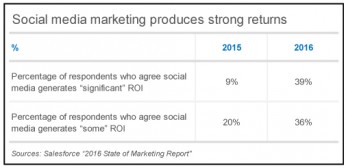Social media is generating better returns on investments this year than it did last year, according to Salesforce’s new “2016 State of Marketing Report.”
The report finds that 75% of retailers and other marketers say that social media delivers either a “strong” or “some” return on their investment. That’s a 46-percentage point increase from the 29% who said so a year earlier.
“Social media marketing is a core piece of a lot of retailers’ businesses,” says Vala Afshar, Salesforce’s chief digital evangelist.
That’s despite the fact that social media led directly to relatively few sales over the most recent holiday season. Only 1.8% of online retail sales over the holidays stemmed from shoppers clicking directly from social networks to retail sites, according to marketing platform vendor Custora, which examined online shoppers’ visits to more than 200 online retail websites.
In part, social media has become a more effective marketing tool because marketers are increasingly developing holistic, cross-channel marketing campaigns rather than developing their social media marketing campaigns in a silo, Afshar says. The report finds that 63% of self-declared “high-performing” marketers integrate social media into their overall marketing strategy, far more than the 28% of marketers who say they are “moderate-performing” and 20% who say they are “low-performing.”
Read more: 75% of marketers say social media marketing is paying off

